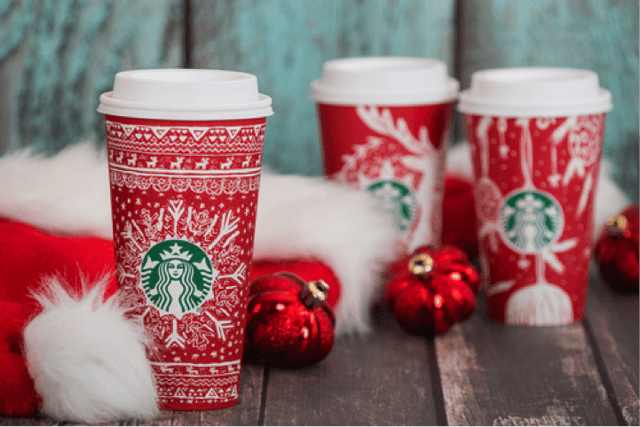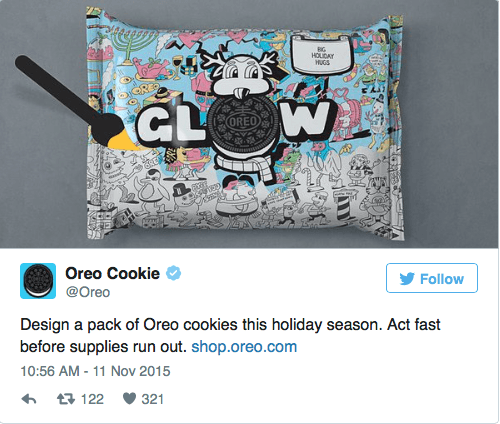It’s the most wonderful—and the busiest—time of the year, especially if you run an eCommerce business. eMarketer predicts online sales to climb 16.6 percent during the 2017 holiday season and online sales hit a record-breaking $2.87 billion this year on Thanksgiving day. Needless to say, eCommerce competition is stiff and every online retailer is trying to get its slice of the pie.
We’ve rounded up a list of big brands that deliver holiday marketing campaigns that make a lasting impact. Even if you don’t have a large budget, there are some important lessons to be learned from these brilliant holiday marketing campaigns.
Tip No. One: Leverage Your Customers to Drive Valuable Solutions
Brand Example: Starbucks’ #RedCups
It would be difficult to find someone who isn’t familiar with Starbucks’ holiday cups after the big controversy over their design in 2015. The coffee giant has been getting its customers in the holiday spirit with the yearly release of its special holiday cups since 1997.
This clever marketing strategy was made even more effective with last year’s initiative. In 2016, Starbucks released thirteen holiday cup designs that featured actual customer designs.
The result? A special holiday cup that pleased (mostly) everyone and won back some lost customers from the previous year’s faux-pas.
Starbucks also upped its game by running a special holiday cup contest on Instagram, encouraging users to submit photos of themselves with their cups for the chance to win a Starbucks gift card. The company raked in a total net revenue of $5.37 billion, so it’s safe to say that this holiday marketing campaign was a huge success.
Key Takeaways:
- Take a customer-centric approach. Some people believed that the red cup controversy was overblown and that only a vocal minority cared about the design. Still, Starbucks listened and found a solution that satisfied their customers.
- Mistakes can be inevitable during the busy holiday season. Be prepared to address any oversight with understanding and, like Starbucks, you can turn things around—and, potentially, turn a customer into a loyal brand ambassador in the process.
Tip No. Two: Use Holiday Influencers to Spread Your Message
Brand Example: Pottery Barn
This is the time of year when consumers become continuously bombarded with holiday messages from brands hoping to make a quick sale. Even loyal customers can grow tired of the constant advertising.
To stand out from the crowd, Pottery Barn tapped on influencers to promote its products in a clever way. By partnering with influencers in the home décor niche, Pottery Barn expertly showcased its products in real homes, demonstrating how holiday shoppers could decorate their own homes in a similar fashion.
Both Pottery Barn and its holiday influencers posted the stunning results on their blogs, along with other digital channels, such as Instagram, Facebook and Pinterest. The authenticity of the company’s strategy won over customers who saw its products outside of a catalog or showroom.
Key Takeaway:
- Don’t underestimate the power of influencer marketing. As a small online retailer, you don’t need to tap big influencers who will drain your budget. Consider partnering with micro-influencers who can drive a significant amount of traffic (and subsequent sales) to your eCommerce store!
Tip No. Three: ‘Tis Better to Give Than to Receive
Brand Example: Ghirardelli Chocolate
Along with increased sales, holiday shoppers are consuming more content around this time of the year. To inspire its customers and generate sales, Ghirardelli Chocolate created numerous holiday gift guides, delicious seasonal recipes and decorating tips to help its audience have a happy holiday season.
Not only did Ghirardelli get to include its own products in these recipes and gift ideas, but the content provided real value to the consumer. To make things even sweeter, the chocolate company gave visitors the ability to create a personalized card through its site’s app, which sent a coupon to the lucky recipient.
Key Takeaway:
- Fulfill consumer needs with content marketing. The holidays are a prime opportunity to help busy holiday shoppers finish their shopping and build a solid relationship with your customers.
It helps to know not only what your audience is searching for, but also when they’re searching for it. Ghirardelli knew that people were interested in specific products at different times of the year by looking at their customer data and performing market research.
You can similarly predict what people are searching for around the holidays with a tool such as Google Trends. Once you know which terms they are using, you can create content centered around these topics and leverage your marketing data to publish them when the moment is right.
Tip No. Four: Evoke a Strong Emotion to Drive Awareness
Brand Example: Macy’s #SantaProject
It’s no secret that many consumers react emotionally rather than logically when it comes to making a purchase. Brands such as Macy’s understand this, which is why it focuses its marketing efforts on eliciting a strong emotional reaction from its audience.
In 2016, Macy’s implemented its “Believe” campaign, which invited kids to write letters to Santa and encouraged people to keep the story of Santa alive. For every letter dropped off at its store, Macy’s donated a dollar to the Make-A-Wish Foundation.
Macy’s relied heavily on social media to spread its campaign’s message, using the hashtag #SantaProject to unite its followers. People were encouraged to post their Santa-related stories, photos, videos and messages across social media to interact with the campaign.
This holiday campaign is a prime example of how impactful marketing can be without directly selling to consumers. Macy’s launched its campaign for a good cause, and this evoked an immensely positive reaction from its audience.
Key Takeaway:
- Use video marketing to get an emotional reaction out of your audience. It doesn’t need to tug at their heartstrings—use this opportunity to be funny in your holiday videos!
Once you’ve created a powerful video, promote it on social media and through your email marketing campaigns. Be sure to use “video” in your subject line to improve click-through rates.
Tip No. Five: Target Your Most Loyal Customers
Brand Example: HBO #12DaysofHBO
In 2015, HBO launched a “12 Days of HBO” campaign that gave loyal subscribers of its streaming service (HBO NOW) the chance to send their friends and family free streaming access to 12 HBO shows. HBO released 12 videos featuring familiar actors from HBO shows, such as Game of Thrones and True Blood, to appeal to its subscribers.
This campaign made the holidays sweeter for many HBO fans and, no doubt, earned HBO a huge number of new subscribers. After all, who can only watch 12 episodes of GoT? However, the success of this campaign was achieved by strictly targeting HBO’s most loyal subscribers.
Key Takeaways:
- You may not have famous actors to promote your products, but you have the next best thing—your own loyal customers. Your biggest fans are your most profitable customers, and you can capitalize on them during the holiday season with the right email segments.
- Create email segments consisting of your most valuable customers and deliver targeted holiday messages to them. This type of segmentation allows you to make better use of your time and marketing budget, not to mention the fact that customers now prefer brands to use their data to deliver personalized emails.
Tip No. Six: Feature Trends in Your Holiday Campaigns
Brand Example: OREO #Colorfilled
When the adult coloring trend took off in 2014, OREO seized the opportunity to use this popular activity in its holiday marketing campaign. The cookie company invited consumers to color the packaging of its original cookie through its direct-to-consumer gift site.
OREO used social media to promote its campaign and encourage customers to personalize their own packages. Using the hashtag #Colorfilled, OREO engaged with fans across Twitter, Facebook and Instagram.
This was OREO’s first foray into direct-to-consumer eCommerce, and the company reported significantly higher conversion rates for their Colorfilled site. OREO picked the right trend to latch on to, and it was rewarded with increased holiday revenue.
Key Takeaway:
- Jumping on a trend can enhance your holiday marketing campaign’s relevancy, but not every trend is worth exploring during the busy holiday season.
OREO’s adult coloring campaign worked because it was a positive and inclusive trend that allowed consumers to personalize its product. If you decide to leverage trends or current events in your holiday marketing, consider how your customers will feel about the trend and how you can tactfully insert your brand into the conversation.
Tip No. Seven: Know Your Customers
Brand Example: REI #OptOutside
REI sparked a national debate when it decided to close its brick-and-mortar stores on Black Friday in support of its “Opt Outside” campaign. In lieu of holding door-busting sales, the outdoor gear and apparel store encouraged its customers to reconnect with the outdoors during the holidays with the hashtag #OptOutside.
This would have been a poor decision for any other big box retailer, but not for REI. The company knew that most of its customers had no desire to wait hours in line for products when they could be enjoying the outdoors.
It was a bold move, but it paid off. Customer engagement was enormous, with 1.4 million people who responded to the #OptOutside hashtag. REI also saw its digital sales go up by 23 percent.
Key Takeaway:
- Taking a risk with your holiday marketing campaigns can help you outshine your competitors, but always consider your customers first. If it benefits your audience, then unconventional marketing strategies may work for your brand. For example, consider launching a campaign that brings attention to an important cause this holiday season. Just make sure that it aligns with your business values and contains a compelling offer to your customer base.
Tip No. Eight: Tell an Engaging Story
Brand Example: Apple’s “Frankie’s Story”
Apple is known for its touching holiday ads, from its award-winning “Misunderstood” ad in 2013 to last year’s commercial titled “Frankie’s Holiday.” Both ads spent less time promoting Apple’s products and focused more on simply telling a heartwarming story with a clear holiday message.
In “Frankie’s Holiday,” we see Frankenstein’s monster trudge through the snow to a town where people are gathered around a tree. Although they are initially shocked at his arrival, a little girl encourages him to come forward to add his contribution to the holiday festivities.
The tagline was “Open Your Heart to Everyone,” and the message was particularly impactful amid the post-election chaos. The ad was thoughtful and timely, and it reminded everyone what the holiday season is truly about.
Key Takeaway:
- It’s easy to get swept up in marketing strategies that aim for a quick and hard sell, but don’t underestimate the value of masterful storytelling. Rather than push its products, Apple focused instead on how mobile devices can bring people together during the holidays.
- Your customers are currently being overwhelmed by holiday messages. Give them a breather and stay present in their mind by providing them with a story-driven approach to marketing. Whether it’s through video, blog posts or Instagram Stories, telling stories can help your brand connect with the right audience.
Tip No. Nine: Encourage User-Generated Content
Brand Example: Coca-Cola’s #WeSleigh
With its iconic polar bears and depiction of Santa Claus, Coca-Cola is the quintessential holiday brand. Since the 1930s, the beverage company has been spreading holiday cheer with its special holiday packaging, creating some spectacular ad campaigns along the way.
Last year, Coca-Cola launched its “Unsung Heroes” campaign to recognize those underappreciated people who make the holiday season a little merrier for the rest of us. The ad featured Cokes being delivered to “unsung heroes,” such as a mom making a holiday meal and a man hanging up holiday lights.
Coca-Cola used influencers to encourage teens to step up during the holiday season and recognize the unsung heroes around them. Using the hashtag #WeSleigh, the campaign inspired fans to submit user-generated content via social media.
Key Takeaways:
- User-Generated Content (UGC) is one of the best ways to grow brand awareness and boost sales. In fact, 85 percent of users are more influenced by UGC than any other marketing effort. Despite this compelling evidence, both large and small brands don’t always do a good job of encouraging a constant flow of user-generated content. To gain a competitive edge this holiday season, take a tip from Coca-Cola and find ways to inspire your audience to create and share content with your brand.
- Remember to choose a hashtag to unite your followers and to boost engagement on social media. Not only will it act as powerful social proof for your online store, but it can provide benefits long after the holidays are over.
Conclusion
As we head into December, the competition is heating up. To gain a greater share of the market this year, your holiday marketing campaigns need to blow your competition out of the water.
Big brands have been facing fierce competition from Amazon and other online retailers for years, forcing them to get extra creative with their holiday marketing campaigns. By looking at their past holiday campaigns, you can take away valuable tips and insight that can fuel your own holiday marketing and give your eCommerce store a competitive edge.






